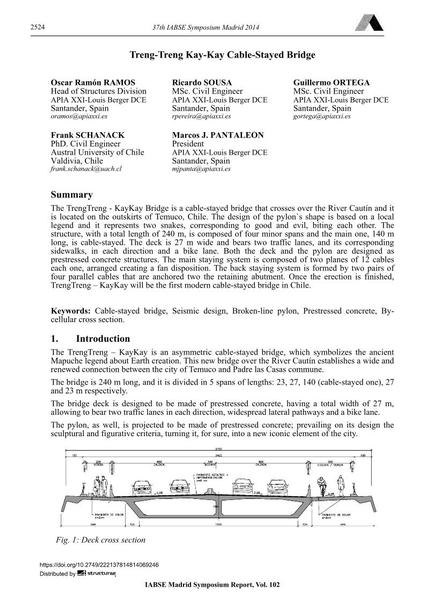Treng-Treng Kay-Kay Cable-Stayed Bridge

|
|
|||||||||||
Bibliographic Details
| Author(s): |
Óscar Ramón Ramos
Ricardo Sousa Guillermo Ortega Frank Schanack Marcos J. Pantaleón |
||||
|---|---|---|---|---|---|
| Medium: | conference paper | ||||
| Language(s): | English | ||||
| Conference: | IABSE Symposium: Engineering for Progress, Nature and People, Madrid, Spain, 3-5 September 2014 | ||||
| Published in: | IABSE Symposium Madrid 2014 | ||||
|
|||||
| Page(s): | 2524-2531 | ||||
| Total no. of pages: | 8 | ||||
| Year: | 2014 | ||||
| DOI: | 10.2749/222137814814069246 | ||||
| Abstract: |
The TrengTreng - KayKay Bridge is a cable-stayed bridge that crosses over the River Cautín and it is located on the outskirts of Temuco, Chile. The design of the pylon`s shape is based on a local legend and it represents two snakes, corresponding to good and evil, biting each other. The structure, with a total length of 240 m, is composed of four minor spans and the main one, 140 m long, is cable-stayed. The deck is 27 m wide and bears two traffic lanes, and its corresponding sidewalks, in each direction and a bike lane. Both the deck and the pylon are designed as prestressed concrete structures. The main staying system is composed of two planes of 12 cables each one, arranged creating a fan disposition. The back staying system is formed by two pairs of four parallel cables that are anchored two the retaining abutment. Once the erection is finished, TrengTreng – KayKay will be the first modern cable-stayed bridge in Chile. |
||||
| Keywords: |
cable-stayed bridge seismic design prestressed concrete Broken-line pylon bi-cellular cross section
|
||||

